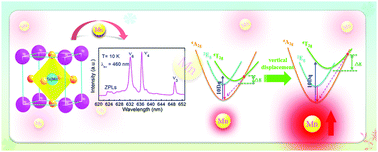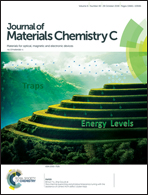Narrow-band red-emitting KZnF3:Mn4+ fluoroperovskites: insights into electronic/vibronic transition and thermal quenching behavior†
Abstract
Mn4+ activated fluoride is known for its unique spectral features and low lost, meeting the urgent requirements for w-LED applications, especially in the field of wide-color-gamut backlights. Despite the ever-growing family, insightful investigations on the host-dependent electronic/vibronic transition and thermal quenching behavior of Mn4+ are insufficient. In this work, a new red-emitting KZnF3:Mn4+ fluoroperovskite is synthesized via a facile co-precipitation method. Systematical studies are performed on its microstructure, electronic structure, and spectroscopic properties. By virtue of high-resolution spectroscopy down to 10 K, both the electronic/vibronic transitions for Mn4+ and [F2−] defect centers are identified, the slight distortion of the [MnF6]2− octahedron deviating from Oh symmetry is disclosed, and multiple crystallographic site occupation of Mn4+ is demonstrated. Moreover, a comparative study on the thermal quenching behavior of different fluoride hosts with nominal Oh symmetry reveals its close dependence on the 4T2g energy position in a configurational coordinate model and provides a rule of thumb to select an appropriate host with good thermal stability.



 Please wait while we load your content...
Please wait while we load your content...